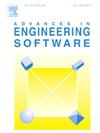Stress-constrained topology optimization of geometrically nonlinear continuum structures by using parallel computing strategy
IF 4
2区 工程技术
Q2 COMPUTER SCIENCE, INTERDISCIPLINARY APPLICATIONS
引用次数: 0
Abstract
Stress-constrained topology optimization under geometrical nonlinear conditions is still an open topic as it often encounter difficulties such as mesh distortion, inaccurate stress evaluation and low computational efficiency. For this purpose, this paper develops a novel parallel-computing based topology optimization methodology for geometrically nonlinear continuum structures with stress constraints. To alleviate the mesh distortions in the low-density regions, a smooth material interpolation scheme from with different penalization for the elastic and nonlinear stiffness is proposed. Moreover, a new hybrid stress finite element formulation is included into the geometrically nonlinear topology optimization to capture a more accurate stress distribution that is less sensitive to mesh distortions. Then, to improve the computational efficiency of geometrically nonlinear and sensitivity analysis, a parallel computing framework based on the assembly free iterative solution is established. Meanwhile, an efficient sparse matrix-vector multiplication strategy, which is applicable to solve the geometrically nonlinear problems, is proposed to exploit the computing power of GPU effectively. Finally, several numerical examples are given to illustrate the efficiency and feasibility of the proposed method.
利用并行计算策略对几何非线性连续结构进行应力约束拓扑优化
几何非线性条件下的应力约束拓扑优化仍然是一个开放性课题,因为它经常遇到网格变形、应力评估不准确和计算效率低等困难。为此,本文针对具有应力约束的几何非线性连续结构,开发了一种基于并行计算的新型拓扑优化方法。为了减轻低密度区域的网格变形,本文提出了一种平滑的材料插值方案,并对弹性和非线性刚度进行了不同的惩罚。此外,在几何非线性拓扑优化中加入了新的混合应力有限元公式,以捕捉更精确的应力分布,降低对网格变形的敏感性。然后,为了提高几何非线性分析和灵敏度分析的计算效率,建立了基于无装配迭代求解的并行计算框架。同时,提出了一种适用于解决几何非线性问题的高效稀疏矩阵-向量乘法策略,以有效利用 GPU 的计算能力。最后,给出了几个数值示例来说明所提方法的效率和可行性。
本文章由计算机程序翻译,如有差异,请以英文原文为准。
求助全文
约1分钟内获得全文
求助全文
来源期刊

Advances in Engineering Software
工程技术-计算机:跨学科应用
CiteScore
7.70
自引率
4.20%
发文量
169
审稿时长
37 days
期刊介绍:
The objective of this journal is to communicate recent and projected advances in computer-based engineering techniques. The fields covered include mechanical, aerospace, civil and environmental engineering, with an emphasis on research and development leading to practical problem-solving.
The scope of the journal includes:
• Innovative computational strategies and numerical algorithms for large-scale engineering problems
• Analysis and simulation techniques and systems
• Model and mesh generation
• Control of the accuracy, stability and efficiency of computational process
• Exploitation of new computing environments (eg distributed hetergeneous and collaborative computing)
• Advanced visualization techniques, virtual environments and prototyping
• Applications of AI, knowledge-based systems, computational intelligence, including fuzzy logic, neural networks and evolutionary computations
• Application of object-oriented technology to engineering problems
• Intelligent human computer interfaces
• Design automation, multidisciplinary design and optimization
• CAD, CAE and integrated process and product development systems
• Quality and reliability.
 求助内容:
求助内容: 应助结果提醒方式:
应助结果提醒方式:


